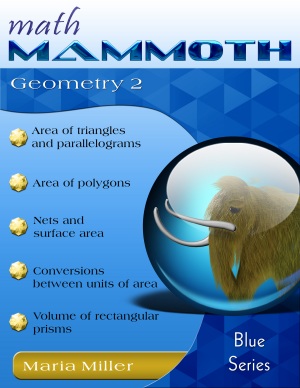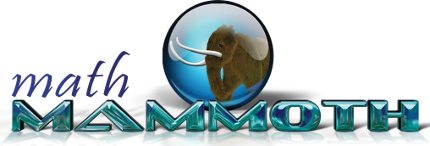Math Mammoth Geometry 2

75 pages
(includes answers)
Sample pages (PDF)
Contents
Area of Parallelograms
Area of Shapes not Drawn on Grid
Nets and Surface Area
Volume problems
Prices & ordering
PDF download USD $3.40
You will be purchasing the downloads from my authorized reseller Comecero.
Printed copy $9.75
Math Mammoth Geometry 2 continues the study of geometry after Math Mammoth Geometry 1, and is most suitable for grade 6. It concentrates on these topics:
- area of triangles;
- area of polygons;
- nets and surface area of prisms and pyramids;
- volume of rectangular prisms with sides of fractional length.
However, the book starts out with some review of topics from earlier grades, as we review the different types of quadrilaterals and triangles and students do some basic drawing exercises. In these drawing problems, students will need a ruler to measure lengths and a protractor to measure angles.
One focus of the book is the area of polygons. To reach this goal, we follow a step-by-step development. First, we study how to find the area of a right triangle, which is very easy, as a right triangle is always half of a rectangle. Next, we build on the idea that the area of a parallelogram is the same as the area of the related rectangle, and from that we develop the usual formula for the area of a parallelogram as the product of its base times its height. This formula then gives us a way to generalize finding the area of any triangle as half of the area of the corresponding parallelogram.
Finally, the area of a polygon can be determined by dividing it into triangles and rectangles, finding the areas of those and summing them. Students also practice their new skills in the context of a coordinate grid. They draw polygons in the coordinate plane and find the lengths of their sides, perimeters and areas.
Nets and surface area is another major topic. Students draw nets and determine the surface area of prisms and pyramids using nets. They also learn how to convert between different area units, not using conversion factors or formulas, but using logical reasoning where they learn to determine those conversion factors themselves.
Lastly, we study the volume of rectangular prisms, this time with edges of fractional length. (Students have already studied this topic in fifth grade with edges that are a whole number long.) The basic idea is to prove that the volume of a rectangular prism can be calculated by multiplying its edge lengths even when the edges have fractional lengths. To that end, students need to think how many little cubes with edges 1⁄2 or 1⁄3 unit go into a larger prism. Once we have established the formula for volume, students solve some problems concerning the volume of rectangular prisms.
You can find some videos that match the lessons in this book at this link (choose 6th grade).
The PDF version of this book can be filled in on a computer, phone, or tablet, using the annotation tools found in many PDF apps. See more.
Note: The contents of this book were updated in February 2022, necessitated by the publishing of Math Mammoth Geometry 4 and the changes in Math Mammoth Geometry 3.
Better Yet - Bundle Deals!
Blue Series - $165 (download)Blue Series for grades 1-3 - $49 (download)
Blue Series for grades 4-5 - $47 (download)
Blue Series for grades 6-8 - $69 (download)
Light Blue Series, grades 1-8 - $225 (download)
Light Blue Series, grades 1-4 - $112.50 (download)
Light Blue Series, grades 5-8 - $112.50 (download)
All Inclusive Bundle - $275 (download)
"Everything" Bundle - $330 (download)
Learn more about the bundles!
*BONUS*: Buy any bundle listed above, and get the fully upgraded Soft-Pak software for FREE (includes 4 math and 2 language arts programs, complete with on screen and printable options).
How and where to order
You can buy Math Mammoth books at:
- Here at MathMammoth.com website — simply use the "Add to cart" buttons you see on the product pages.
- Rainbow Resource carries printed copies for the Light Blue series books, plus several CDs (Light Blue and Blue series).
- Homeschool Buyers Club offers download versions of the Light Blue series, plus the Blue series bundle.
- Homeschool Planet sells the digital versions of the main curriculum and lesson plans to go with them.
- K5 Learning offers download versions of the Blue series.
- TPT sells the Light Blue Series downloads, plus topical units.
- Lulu sells printed copies for most of the Math Mammoth materials (various series).
By purchasing any of the books, permission IS granted for the teacher (or parent) to reproduce this material to be used with his/her students in a teaching situation; not for commercial resale. However, you are not permitted to share the material with another teacher.
In other words, you are permitted to make copies for the students/children you are teaching, but not for other teachers' usage.
Math Mammoth books are PDF files. I recommend you use Adobe Reader to view them, including if you use a Mac. You can try other PDF viewers, but they may at times either omit or mess up some of the images.
Receive my monthly collection of math tips & resources directly in your inbox — and get a FREE Math Mammoth book!
You can unsubscribe at any time.
Math Mammoth TourConfused about the different options? Take a virtual email tour around Math Mammoth! You'll receive: An initial email to download your GIFT of over 400 free worksheets and sample pages from my books. Six other "TOURSTOP" emails that explain the important things and commonly asked questions concerning Math Mammoth curriculum. (Find out the differences between all these different-colored series!)This way, you'll have time to digest the information over one or two weeks, plus an opportunity to ask me personally about the curriculum. A monthly collection of math teaching tips & Math Mammoth updates (unsubscribe any time) We respect your email privacy.
Note: You will FIRST get an email that asks you to confirm your email address. If you cannot find this confirmation email, please check your SPAM/JUNK folder. |
"Mini" Math Teaching CourseThis is a little "virtual" 2-week course, where you will receive emails on important topics on teaching math, including:
- How to help a student who is behind You will also receive: A GIFT of over 400 free worksheets and sample pages from my books right in the very beginning.We respect your email privacy.
Note: You will FIRST get an email that asks you to confirm your email address. If you cannot find this confirmation email, please check your SPAM/JUNK folder. |
Maria's Math TipsEnter your email to receive math teaching tips, resources, Math Mammoth news & sales, humor, and more! I tend to send out these tips about once monthly, near the beginning of the month, but occasionally you may hear from me twice per month (and sometimes less often). Peek at the previous tips here. You will also receive:
We respect your email privacy.
|
|
